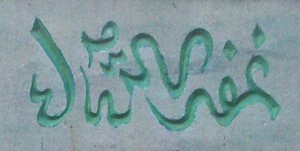Ever have one of those days when Chinese characters twist the dagger and shake on salt? In this case the weapon of choice was a sharp chisel:
 There I was, in the botanical garden near the beautiful Xiamen offices of Sinoglot, Inc during a pre-Chinese New Year visit. My host, Xiamen head enchilada Randy, was too far down the trail for me to ask, so I was left with only my inflexible brain and its all-too-meager store of Chinese characters, wondering what in the heck 互 was doing on this stone and why it was missing part of its innards.
There I was, in the botanical garden near the beautiful Xiamen offices of Sinoglot, Inc during a pre-Chinese New Year visit. My host, Xiamen head enchilada Randy, was too far down the trail for me to ask, so I was left with only my inflexible brain and its all-too-meager store of Chinese characters, wondering what in the heck 互 was doing on this stone and why it was missing part of its innards.
Naturally, I was completely wrong, as my first available informant laughed and told me. She said it was 工 and this was a common stylized way of stone-carving the character.
Ouch. Not only is 工 (gōng = work) one of the first characters any learner acquires, it was also in a word and context I should have recognized: 竣工, jùngōng, means to “complete work”, and 日期, rìqī, is just “date”. Yet there I was, as dumbfounded as Caesar when he saw Brutus with the dagger*.
Not to worry, though, it was just one little character slip-up, right?
I’m afraid the long-term prospects aren’t any better — no hope of a merciful end to this character assassination business. With thousands of characters making cameos in endless and weird fonts, handwriting, cursives, brush script… there’s only a future that seems closer to, well, slow slicing. In the meantime, if you’ve got an unkind cut story of your own, the sharing might at least be analgesic.
– – –
*Oh yeah, about that post title and theme: Chinese characters as assassins of my limited brainpower? The hyperbole might be indulgent, but at least I didn’t bring up Nazi Germany.
 Text Messages”, it means you don’t have proper Yi syllables font support.
Text Messages”, it means you don’t have proper Yi syllables font support.  Syz
Syz 

 There I was, in the botanical garden near the beautiful Xiamen offices of Sinoglot, Inc during a pre-Chinese New Year visit. My host, Xiamen head enchilada Randy, was too far down the trail for me to ask, so I was left with only my inflexible brain and its all-too-meager store of Chinese characters, wondering what in the heck 互 was doing on this stone and why it was missing part of its innards.
There I was, in the botanical garden near the beautiful Xiamen offices of Sinoglot, Inc during a pre-Chinese New Year visit. My host, Xiamen head enchilada Randy, was too far down the trail for me to ask, so I was left with only my inflexible brain and its all-too-meager store of Chinese characters, wondering what in the heck 互 was doing on this stone and why it was missing part of its innards.